This post may contain affiliate links. Please read our disclosure policy. As an Amazon Associate, I earn from qualifying purchases.
Our Puerto Rican pork roast recipe results in the juiciest and most tender roast pork you’ve ever had! A three-day marinade in a special Puerto Rican spicy garlic paste infuses the meat with intense flavor. The thick pig skin cap, also known as a chicharrón, turns out perfectly crisp.
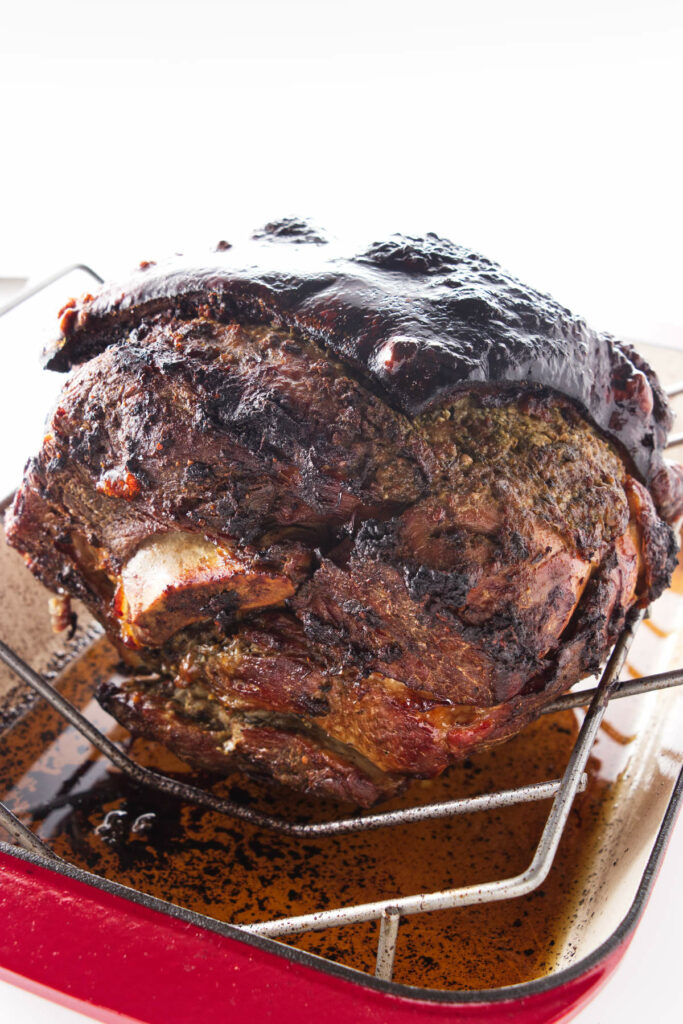
Why This Puerto Rican Pernil Recipe Works:
Puerto Rican pork shoulder is also known as pernil or pernil asado in Puerto Rico. It’s marinated in a special blend of flavorful spices and herbs, then slow roasted to get perfect, fall-off-the-bone pernil with crispy skin.
Typically, pernil is served for holidays or special occasions. But once you try this Puerto Rican pork roast, you’ll see why it is a special occasion.
A pork shoulder roast is a favorite of ours. If you’ve ever made our slow-roasted pork shoulder or our cider braised pork shoulder with apples, you are already familiar with how tender and flavorful this relatively inexpensive cut of meat turns out.
But there’s even more to love about this pernil asado recipe. Other than the bold flavors, tender meat and crispy fat cap, Puerto Rican pulled pork is the recipe for a crowd. You’ll end up with lots of servings so there’s plenty to go around (and exciting leftovers afterward!).
Puerto Rican Pernil Ingredient List
The ingredient list for our pernil asado recipe is quite simple. Only a few ingredients are required for this skin-on pork, and the majority are spices.
You’ll need plenty of fresh garlic cloves (two whole garlic heads to be exact!) and just under a dozen ingredients to make a flavorful Puerto Rican pork shoulder.
Here’s the ingredient list:
- Pork shoulder, skin-on, bone-in (sometimes labeled “Picnic Pork Roast”)
- White vinegar
- Garlic
- Sofrito (red or green)
- Adobo seasoning
- Dried oregano leaves
- Onion powder
- Sazón seasoning
- Ground cumin
- Kosher salt
- Black pepper
Adobo is a salty spice rub, and seasoning that’s popular in Latin American cuisine and Sazón is a Puerto Rican flavoring base. The same goes for red or green sofrito (also called recaito). You can typically find these products in most grocery stores as well as Latin American markets.
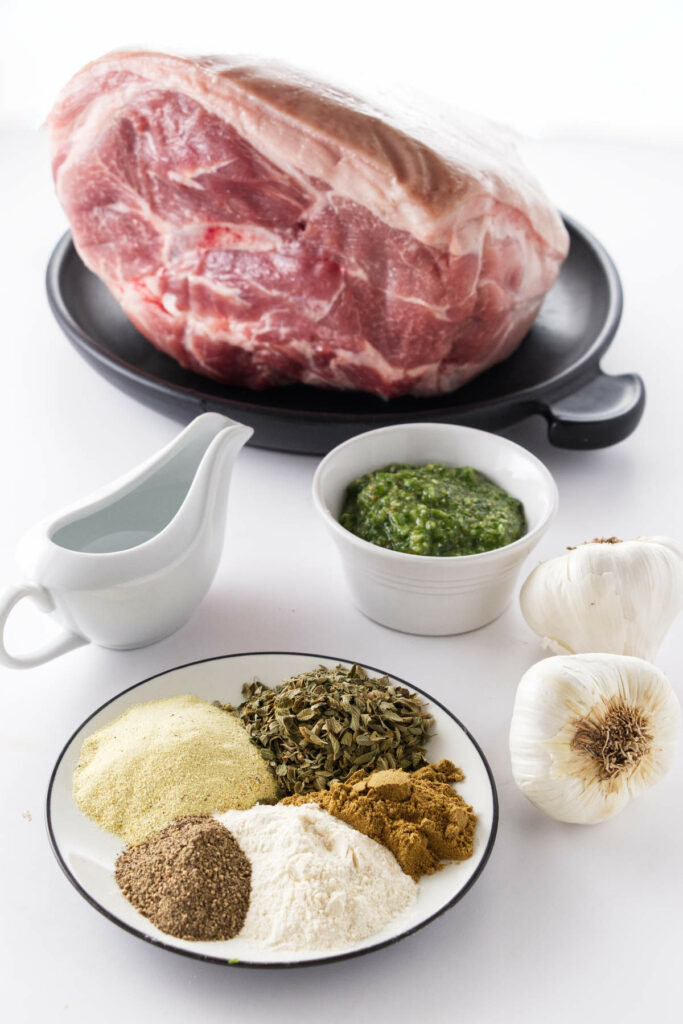
How to Make Our Pernil Recipe with Crispy Skin:
The great thing about this pernil asado recipe is that it’s simple to prepare, and the magic happens in the three-day-long marinade.
Here’s a quick look at how to make it, but scroll down to the printable recipe card for all the details.
Prepare the Pork Overnight
- Cut the pork shoulder: Using a sharp knife, cut across the front between where the fat and skin join. Cut a couple of inches on each side and gently pull and lift the skin a little bit to create a pocket between the layer of fat and meat.
Pull it back a bit and make shallow cuts in the pork flesh (you can use a paring knife to make sure they’re not deep cuts- don’t cut into the skin). Turn the pork over and make a few cuts into the bottom of the roast.
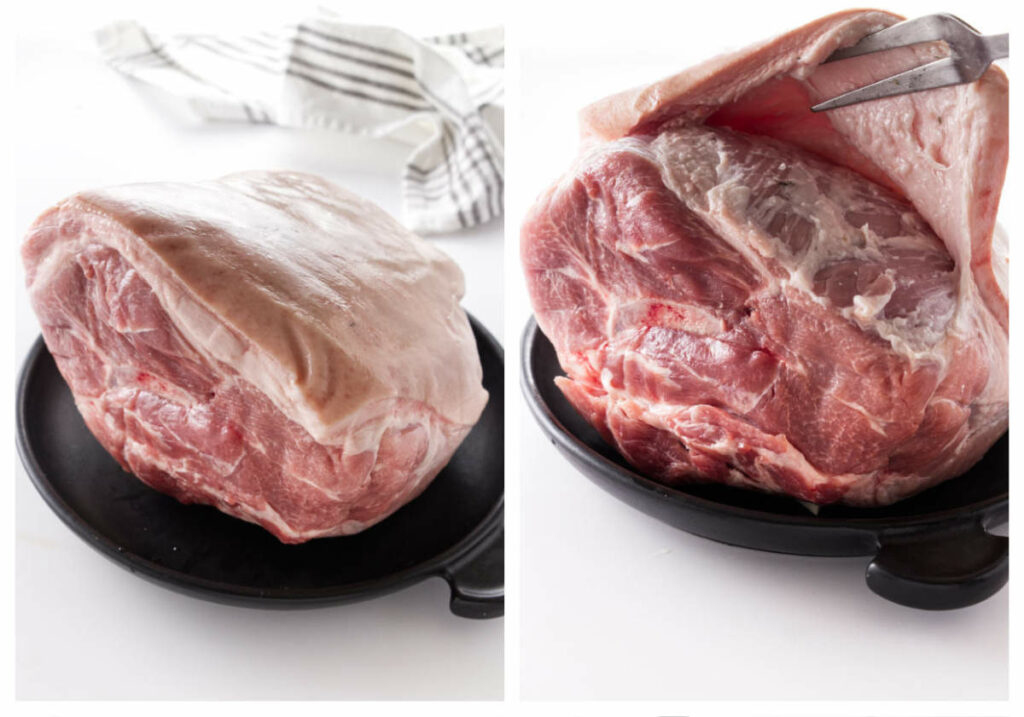
Leave the skin on the pork shoulder and cut. Slide your knife under the skin to make a pocket and expose the flesh.
- Wash the pork shoulder: Place the pork into a large basin and pour vinegar all over it. Rub it in then set it aside while you make the paste.
- Prepare the seasoning paste: In a small bowl, combine the grated garlic, sofrito, and all the seasonings.
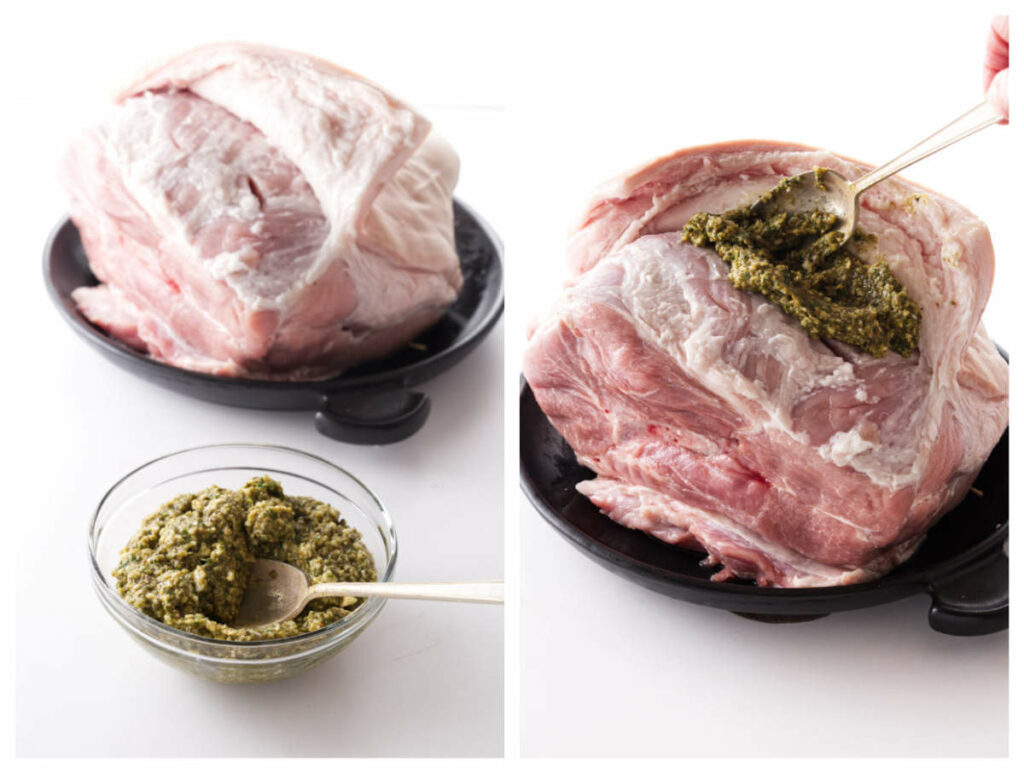
- Season the roast: Rub the paste all over the pork roast. Make sure to get under the skin and into all the cuts. Cover the roast and stick it in the fridge for three days.
Roast the Pork Shoulder:
- Roast the pork: Wipe the paste off the pork skin and dry it with a paper towel. Set the pork on a roasting rack, cover the pan and roast it in the oven.
- Crisp the pork skin: When the pork roast is finished cooking, turn the oven up to 425°F to crisp up the skin. The skin will start to blister and get brown. Remove the roast from the oven and let it rest for 30 minutes.
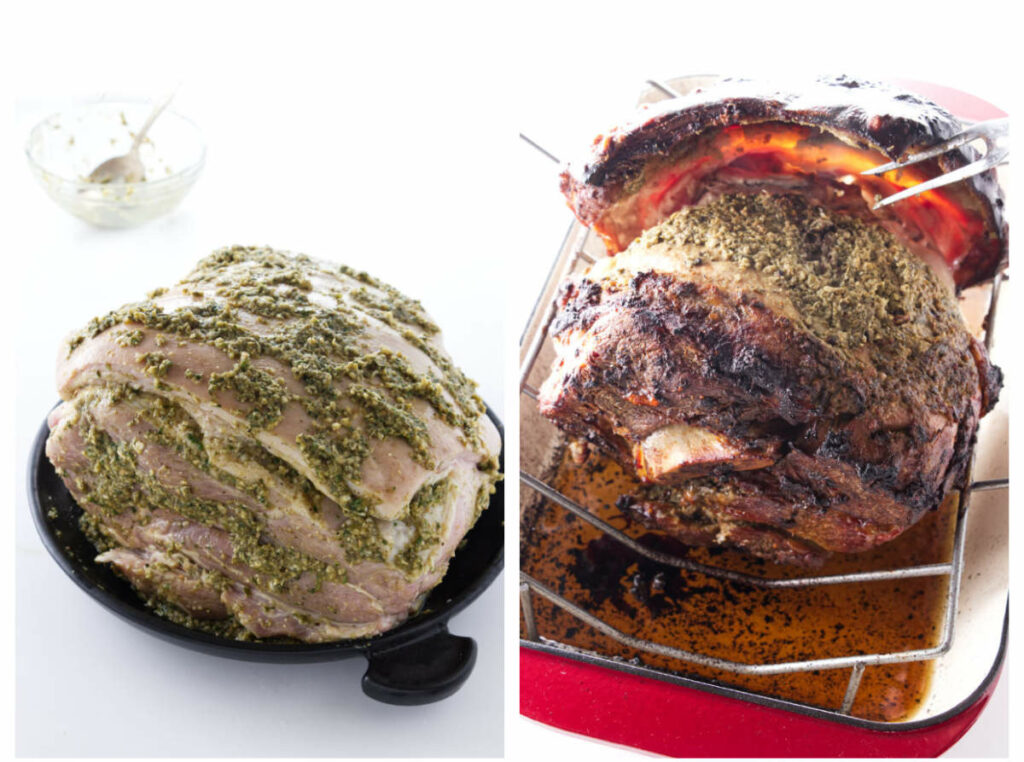
Tip: Remove the sofrito from the top of the skin and dry the skin before you roast the pork shoulder. However, leave the sofrito on the rest of the roast. You only want to remove it from the top of the skin so it does not burn on top.
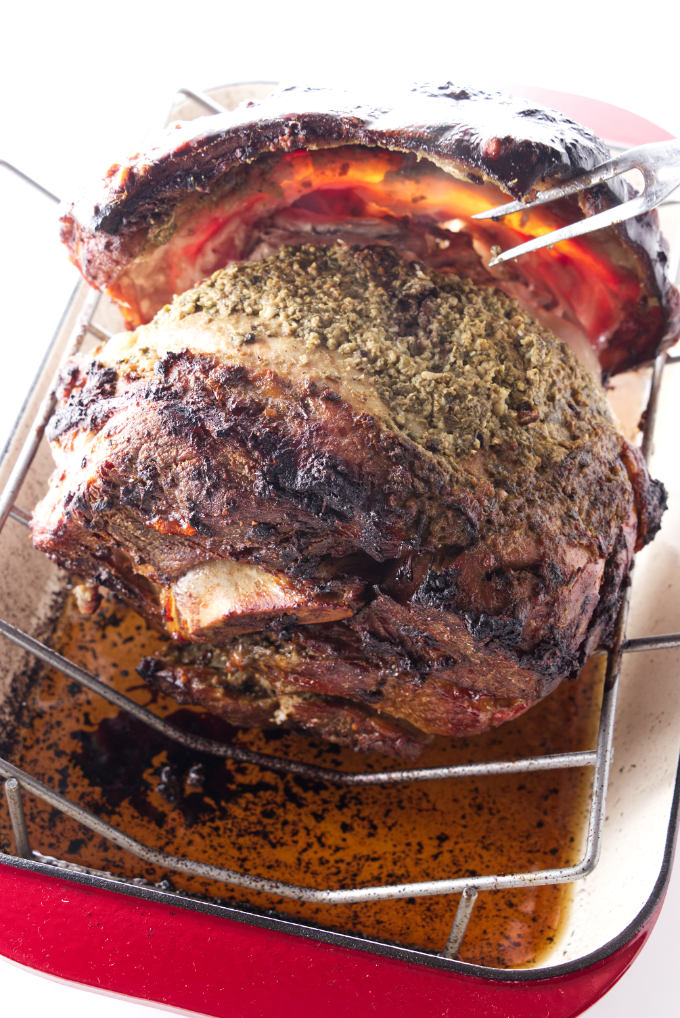
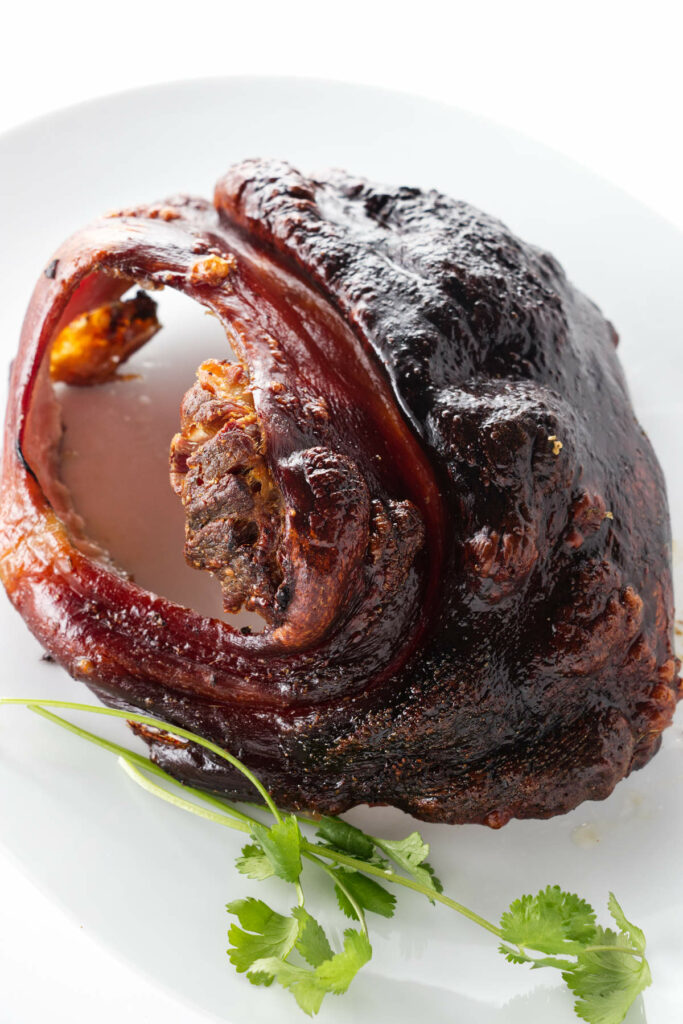
Serve the crispy pork skin along with the pulled pork. You can break the skin up into pieces or keep it whole. Serve with lime wedges if desired.
If you like this recipe, you will love our Porchetta.
Recipe Tips for the Best Results
- Don’t skip the vinegar wash step! It helps break down the connective tissue of the pork and results in an extra tender roasted pork shoulder.
- The meat is ready when the internal temperature reads between 180°F and 200°F with a meat thermometer. If you are wondering “how do you use a meat thermometer“, you can check out our post on that as well.
- Wrapping the pork shoulder tightly with plastic wrap will force the flavor into the meat. Make sure to wipe the spice paste from the pork before roasting otherwise it will char.
- You can marinate the pork overnight anywhere between 8 hours and up to 3 days. The longer it marinates, the more intense the flavor will be.
- Be sure to spray the aluminum foil with non-stick oil so that it doesn’t stick to the pork skin.
- Transfer the pork to a clean pan or wire rack for the final crisping of the skin. The high temperature will cause a lot of smoke otherwise.
Roasting Times for Puerto Rican Pulled Pork
Adjust the roasting time for this Puerto Rican Pernil recipe based on the size of the pork roast.
To calculate the roasting time for an oven temperature of 350°F, add 35 minutes per pound:
- 5 pounds = 3-hour roast time
- 7 pounds = 4-hour roast time
- 10 pounds = 6-hour roast time
This pernil recipe makes a tender pork shoulder with crispy skin that’s super flavorful- the ultimate crowd pleaser of a meal!
It’s wonderful for special occasions, family gatherings or a holiday meal. Leftover pernil also tastes great the next day (and days following) and there are so many different ways to enjoy it.
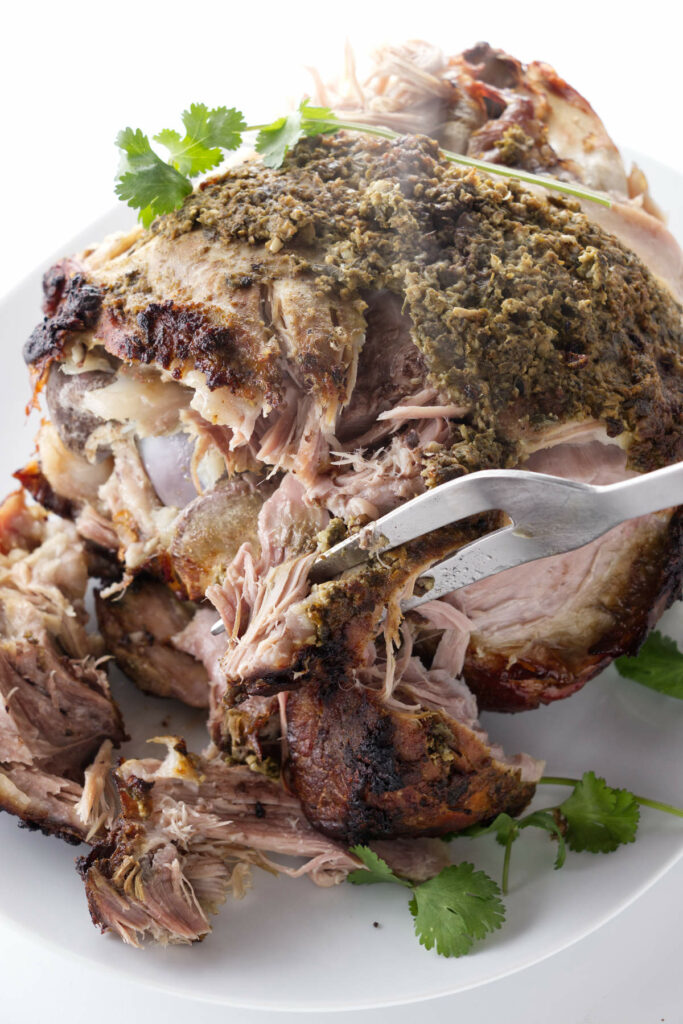
Some Other Recipes We Are Sure You Will Love:
Instant Pot Spanish Rice is delicious with pernil asado. Tender, seasoned perfectly and downright delicious, you’ll love this simple and flavor-packed side dish that goes with just about anything.
Kamut Flour Tortillas are so easy to make yourself and we know you’ll love the hearty flavor of these homemade tortillas. They’re simple, versatile, and make the perfect pairing with our Puerto Rican pork shoulder.
Shrimp Diablo is a fast and easy dish that is perfect for busy weeknights. Simmered in a spicy tomato sauce with loads of seasonings, you’ll love this under-30-minute meal.
Pin this now to find it later!
Pin It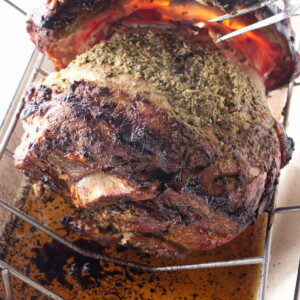
Puerto Rican Roast Pork Shoulder (Pernil)
If you make this recipe, please leave a star rating and comment.
Ingredients
- 10 pound pork shoulder, skin-on, bone-in (picnic shoulder)
- ½ cup white vinegar
- 2 whole garlic head, peeled and grated or crushed
- ⅓ cup Sofrito, red or green
- 2 tablespoons Adobo seasoning
- 2 tablespoons dried oregano
- 2 tablespoons onion powder
- 1 ½ tablespoons Sazón, 3 packets
- 2 tablespoons ground cumin
- ½ tablespoons Kosher salt
- 1 teaspoon ground black pepper
Instructions
Prep the Pork Shoulder:
- Use a sharp knife to carefully cut across the front where the fat and skin join. Cut only a couple of inches on each side and gently pull and lift the skin loose to create a pocket between the skin and the flesh.
- Pull the skin back a little and make shallow cuts into the pork flesh. Do not cut into the skin.
- Turn the pork over and make a few cuts into the bottom of the pork.
- Place the pork in a large basin and pour the vinegar all over the pork shoulder. Make sure you get under the skin and rub it all over the meat. Do not rinse the vinegar off with water.
- Set the pork on a large plate and reserve while preparing the paste.
- In a small bowl, add the grated garlic, sofrito, adobo seasoning, oregano leaves, onion powder, Sazón, cumin, salt, and black pepper. Stir to make a thick paste.
- Spoon 1/3 of the paste into the pocket between the skin and the flesh. Rub it into the cuts and the flesh.
- Turn the pork over and rub another 1/3 of the paste on the bottom of the pork and into the cuts.
- Turn the pork over, skin side up and use the remaining 1/3 of the paste to rub into the sides of the pork.
- Wrap the pork completely in plastic wrap, pulling the wrap tightly around the pork. Then wrap the entire package with aluminum foil and place it on a plate. Place in the refrigerator to marinate for up to 3 days.
Roast the Pork Shoulder:
- Remove the pork shoulder from the refrigerator. Discard the foil and plastic and wipe off the paste from the top of the pork skin. Dry the skin with a paper towel and allow the pork to rest for 30 minutes.
- Preheat the oven to 350°F Adjust the oven rack to the lower 1/3 position.
- Place a roasting rack inside a large roasting pan and spray with non-stick oil. Spray a large sheet of foil with non-stick oil. Set the pork in the roasting rack and cover the pan with the oiled foil.
- Roast the pork shoulder for 5 hours or until the internal temperature is between 175°F and 205°F. Cook to 175°F to 180°F if you want to slice the pork or cook to 200°F to 205°F for shredded pork.
- Remove the pan from the oven and remove the foil. Increase the oven temperature to 425°F and return the roast to the oven to crisp and blister the skin. Watch closely, turning every few minutes to get the skin browned, crisped, and blistered evenly.
- Remove the roast and let it rest for 30 minutes.
- When ready to serve, remove the crisp pork skin from the flesh, break or cut it into sections and serve separately. Transfer the pork shoulder to a platter and either shred or pull chunks off and serve.
Notes
- The vinegar wash helps to break down the tough connective tissue of the pork shoulder.
- Sazón is a Puerto Rican herb flavoring base that can be purchased in most local grocery stores in the international foods aisle. If you can’t find it, blend equal parts of ground coriander, cumin, garlic powder, and onion powder.
- Adobo is a blend of Latin or Spanish spices used as an all-purpose seasoning.
- Wrapping the pork tightly with plastic wrap will force flavor into the meat.
- The pork can be roasted after 8-hours of marinating and up to 3 days. The longer the marinade time, the better flavor.
- When ready to roast wipe the spice paste from the pork otherwise it will char while roasting.
- Be sure to coat the foil with oil spray so that it does not stick to the pork skin.
- If possible, transfer the pork to a clean pan/rack for the final crisping of the skin as the increased temperature will cause a lot of smoke otherwise.
- Calculate roasting times for different sizes of pork shoulder at 350°F for 35 minutes per pound to an internal temperature of 180°F. (5 pounds=3 hours, 7 pounds=4 hours, 10 pounds=6 hours)
- Cook the pork to 200°F to 205°F if you want to shred it like pulled pork. 175°F to 180°F is perfect if you want to slice the pork.
Nutrition
Nutrition information is automatically calculated, so should only be used as an approximation.
 Like this recipe? Rate & comment below!
Like this recipe? Rate & comment below!
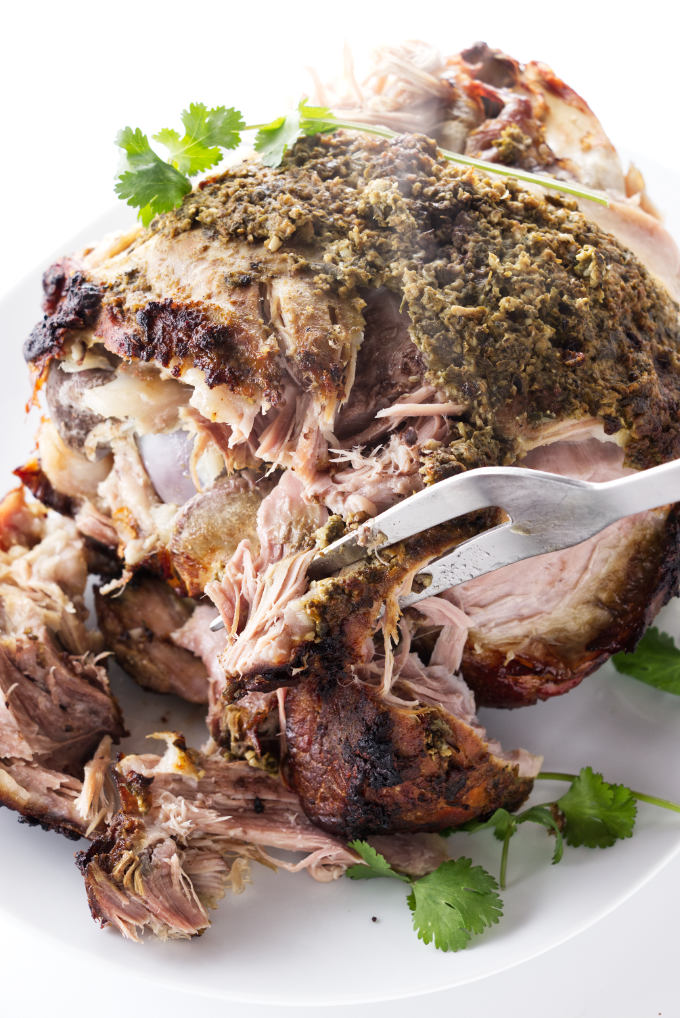
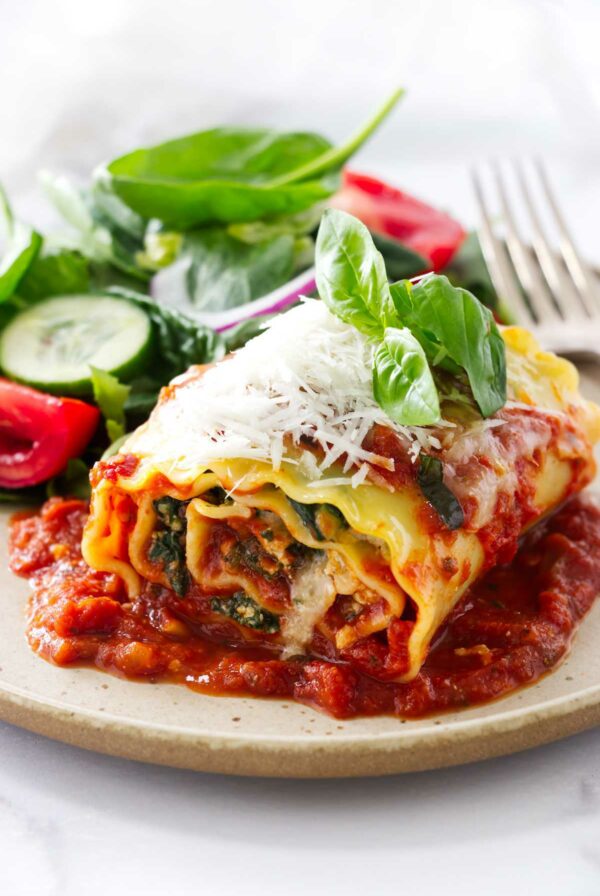
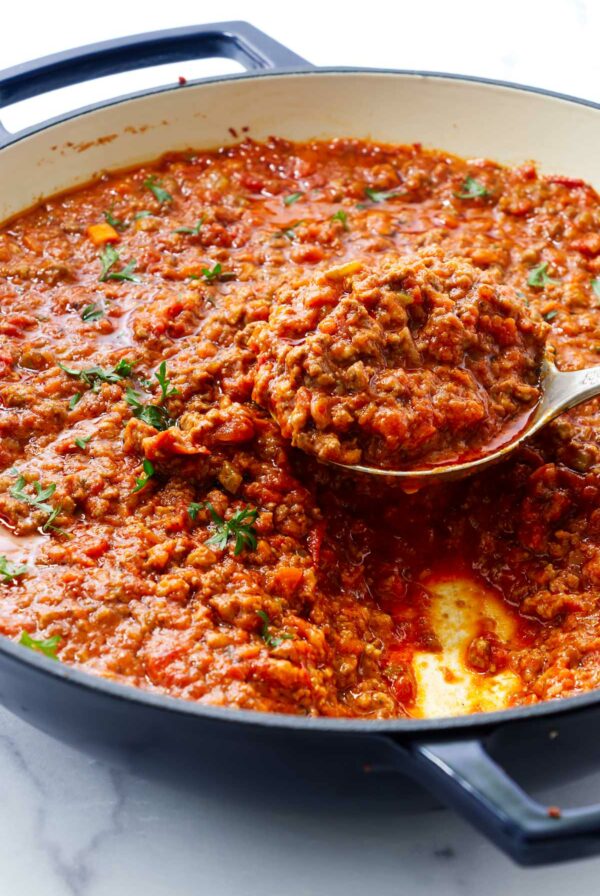
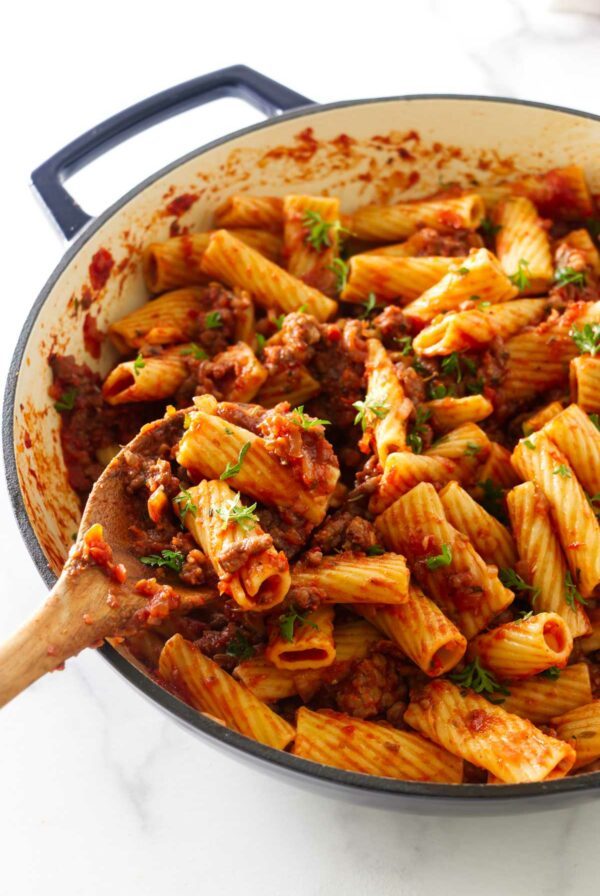
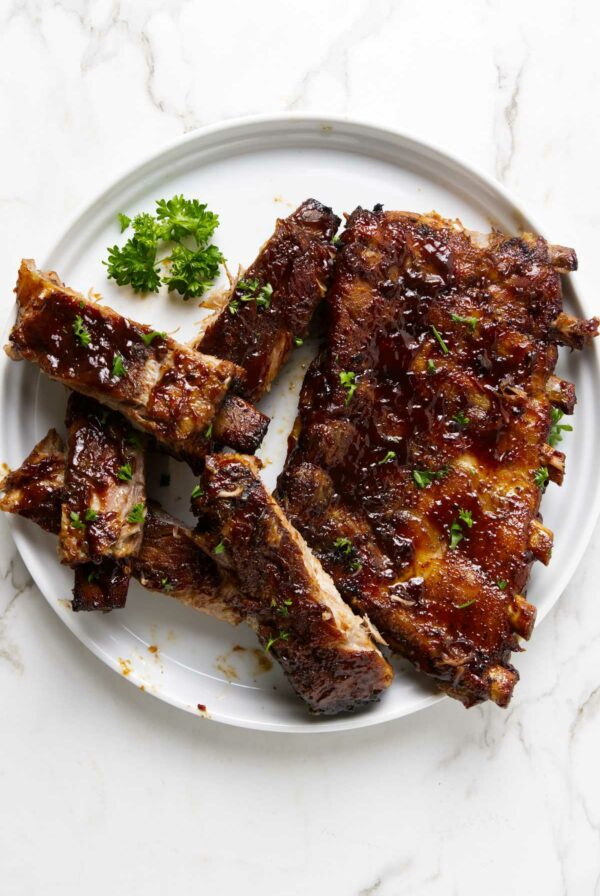










Have you ever done this in a croc pot?
We have not. It should work in a crockpot if you set the slow cooker on high for 6 to 8 hours. If you want a crispy skin you will need to finish it in the oven.
Do you mix the Sazon in the paste? I didn’t see you mention it in the instructions.
Yes, thanks for catching that. Mix the Sazon with the other seasonings to make a paste.
Gosh, this looks beyond delicious!